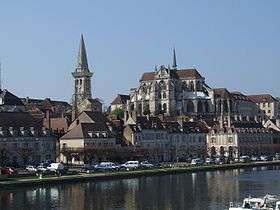Abbey of Saint-Germain d'Auxerre
The Abbey of Saint-Germain d'Auxerre was a Benedictine monastery in central France,[1][2] dedicated to its founder Saint Germain of Auxerre, the bishop of Auxerre, who died in 448. The abbey reached the apex of its cultural importance during the Carolingian era; the source for its early history is an account of the Miracula Sancti Germani Episcopi Autissiodorensis ("Miracles of Saint Germain, Bishop of Auxerre") written before ca. 880. The earliest surviving architectural remains are also of the ninth century.[3]
In 1927, beneath the 17th-century frescoed plaster walls of the crypt, were discovered ninth-century wall frescoes, the only surviving large-scale paintings of their date in France to compare to the illuminated manuscripts.[4]
During the Revolution, several bays of the nave were demolished and the secularized abbey was used as a hospital. The former nave extended beneath the present forecourt.
In the late twentieth century the abbey's residential and service buildings were remodeled as a museum, presenting prehistoric, Gallo-Roman and medieval finds from Auxerre. An exhibition in 1990 brought the abbey's cultural impact into focus. The former abbey church remains in use for worship at stated times.
Known Abbotts
- ? - 622: Palladius Auxerre
- [...]? - 886? : Abbot Hugh 10 († 12 May 886)
- 894-921: Richard Duke of Bourgogne11. ? -? : Heldric7,12 († 999), contemporary of St. Sévin Bishop of Sens.
- 1104: Hugues de Montaigu, son of Dalmace Semur said Jeune14 approve this year a charter for the benefit of the Priory of Saint-Marcel Fleurey-sur-Ouche, signed by Duke Hugh II Bourgogne15. It will be bishop of Auxerre.
- 1st half of the thirteenth century: Renaud Jocenal (alive May 13, 1222)
- 1285 - 1309: Guy Munois
- 1309 - 1334: Left Dignon Chéu
- 1334 - 1353: Étienne 1 Chitry
- 1353 - 1362: William Grimoard, future Pope Urban V
- 1362 - 1381: Stephen II Chitry
- 1381 - 1408: Hugues V of Ballore
- 1409 - 1422: John II of Nanton
- 1422/1423 - 1453: Hervé de Lugny
- 1453 - 1495: Hugues VI Tyard or Thiard
- 1542: Louis Lorraine17
- 1731: Dom Leonardo Le Texier, Grand Prior (1731).
Notes
- ↑ Jean Lebeuf, Mémoire concernant l’histoire ecclésiastique et civile d’Auxerre, vol. 1, Auxerre, Perriquet, 1743, 886
- ↑ Jean Lebeuf, Mémoire concernant l’histoire ecclésiastique et civile d’Auxerre, vol. 1, 1848, 544
- ↑ Vaast-Barthélemy Henry, Mémoires historiques sur la ville de Seignelay, département de l'Yonne, depuis sa fondation au VIIIe siècle, jusqu'en 1830 ; précédés de recherches sur l'état du pays au temps des Gaulois et des Romains ; et suivie d'une notice historique sur les communes environnantes, avec les principales pièces justificatives, vol. 1 et 2, Avallon, Éd. (Comynet, 1833), p369 & 370
- ↑ Edward S. King, "The Carolingian Frescoes of the Abbey of Saint Germain d'Auxerre" The Art Bulletin;; 11.4 (December 1929), pp. 357-375.
References
- Christian Sapin, La Bourgogne préromane (Paris, 1986), pp. 41–63 (on the early building project)
- Abbaye Saint-Germain d'Auxerre: intellectuels et artistes dans l'Europe carolingienne, IXe - XIe siecles (Auxerre, 1990) Exhibition catalogue.
- Auxerre et les prémices de l'art roman (Auxerre, 1999) Exhibition catalogue.
- Noëlle Deflou-Leca, Saint-Germain d'Auxerre et ses dépendances (Ve-XIIIe siècle), PSE, 2010, p773.
External links
- Culture.gouv.fr: Saint-Germain d'Auxerre (English)
- Saint Germain d'Auxerre: recent archaeology
- Saint Germain d'Auxerre on the site Bourgogne Romane
Coordinates: 47°48′2″N 3°34′22″E / 47.80056°N 3.57278°E
